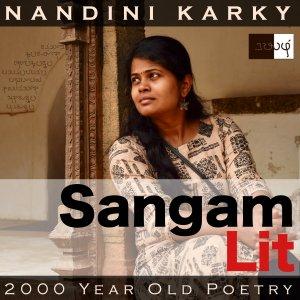Sangam Lit

Aganaanooru 64 – Return home to love
In this episode, we perceive a man’s fervent wish, as depicted in Sangam Literary work, Aganaanooru 64, penned by Aarkkaadu Kizhaar Makanaar Vellai Kannathanaar. The verse is situated amidst the moist red lands of the ‘Mullai’ or ‘Forest Landscape’ and sketches the yearning to return home after a mission.
களையும் இடனால் பாக! உளை அணி
உலகு கடப்பன்ன புள் இயற் கலி மா
வகை அமை வனப்பின் வள்பு நீ தெரிய,
தளவுப் பிணி அவிழ்ந்த தண் பதப் பெரு வழி,
ஐது இலங்கு அகல் இலை நெய் கனி நோன் காழ்
வெள் வேல் இளையர் வீங்கு பரி முடுக,
செலவு நாம் அயர்ந்தனம்ஆயின், பெயல
கடு நீர் வரித்த செந் நிலமருங்கின்,
விடு நெறி ஈர் மணல், வாரணம் சிதர,
பாம்பு உறை புற்றத்து ஈர்ம் புறம் குத்தி,
மண்ணுடைக் கோட்ட அண்ணல் ஏஎறு
உடன் நிலை வேட்கையின் மட நாகு தழீஇ,
ஊர்வயின் பெயரும் பொழுதில், சேர்பு உடன்,
கன்று பயிர் குரல, மன்று நிறை புகுதரும்
ஆ பூண் தெண் மணி ஐது இயம்பு இன் இசை
புலம்பு கொள் மாலை கேட்டொறும்
கலங்கினள் உறைவோள் கையறு நிலையே.
The fragrant forests reveal the passion in the man’s heart as he renders these words to his charioteer, when returning home after completing his mission:
“It’s time to slay it, O charioteer! Wield those exquisite reins that you know so well, tied around the neck of the proud horse, with a swaying mane, which moves, akin to a bird that traverses the world entire. On the huge road, filled with moisture, where wild jasmines have burst in bloom, and where young aides, holding victorious spears, with beautiful, radiant, wide leaf edges, and well-oiled, smooth and sturdy stems, walk on, hasten the horses so that we overtake them! We should put our mind to our speedy return.
On the red land paved with lines, owing to the heavy downpour on the side of the chariot’s path, birds peck around on the wet mud. Dashing against the side of termite mounds, where snakes reside, the esteemed bull becomes covered in mud, and wanting to be together with its mate forever, it embraces the naive young cow in the village. When returning thither from their grazing, the cattle, call out together to their calves, and rush to the village centre, with the sound of their clear bells, rising in a sweet music in that loneliness-filled evening. Whenever she hears this, she would lament and suffer. And so, we should hasten and end this state of helplessness of the one, who tearfully resides back home!”
Let’s listen to this song set in rhythm to the tinkling of cow bells. The man starts by saying to the charioteer it was time to change something. Without saying what it is, he goes on to describe the horse running ahead, with its dancing mane, and he compares the movement of this animal to a bird that crosses the world. A moment to pause and reflect on this mention of migration in birds, which traverse thousands of kilometres, and in fact, journey from pole to pole, region to region, as documented by modern science. That a poet from two thousand years ago makes this observation, from one corner of the earth, without knowing so much about other parts of the world, is something deeply perceptive, and goes on to show the scientific thinking of these ancients.
Returning, the man tells his charioteer to wield the reins firmly and ride with speed, so that they overtake the young aides on foot, carrying spears. He describes the red soil of the forest, and how lines seem to be carved on it by the pouring rains, and here, forest fowl are seen pecking around, and bulls are coated with red mud, as they dash against termite mounds, where snakes lie sleeping. As a projection of the man’s mind, these bulls are seen embracing their mates in the village. And when evening falls, huge herds of cattle return after their grazing, crying out for their calves, with their bells tinkling, and this is the music that would fall on the lady’s ears and fill her with a deep melancholy, says the man. He concludes by telling his charioteer that they must rush home and slay this state of suffering of his beloved.
The verse once again echoes the timeless theme of that burning urgency to be back in the company of love when the work that tore apart the lovers is done with! Take away the speeding chariot and the still forest, and if you place a sailor, a pilot, an astronaut in the scene, you can hear the same heartbeat of this Sangam man in each one of them at the end of their voyage!






 Visit Podcast Website
Visit Podcast Website RSS Podcast Feed
RSS Podcast Feed Subscribe
Subscribe
 Add to MyCast
Add to MyCast